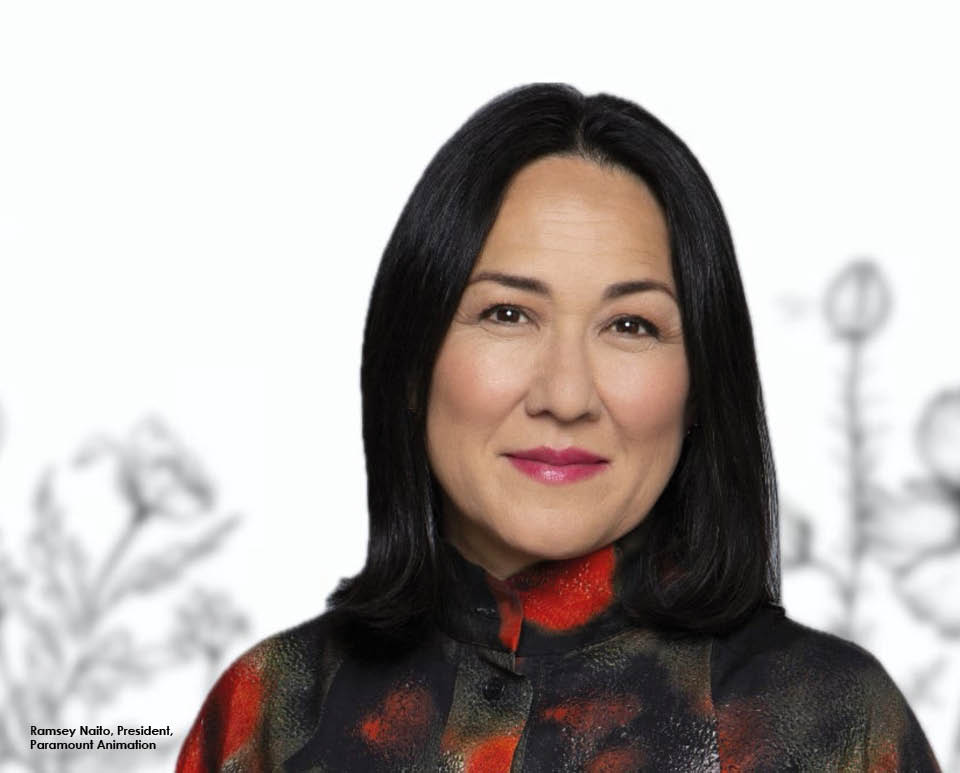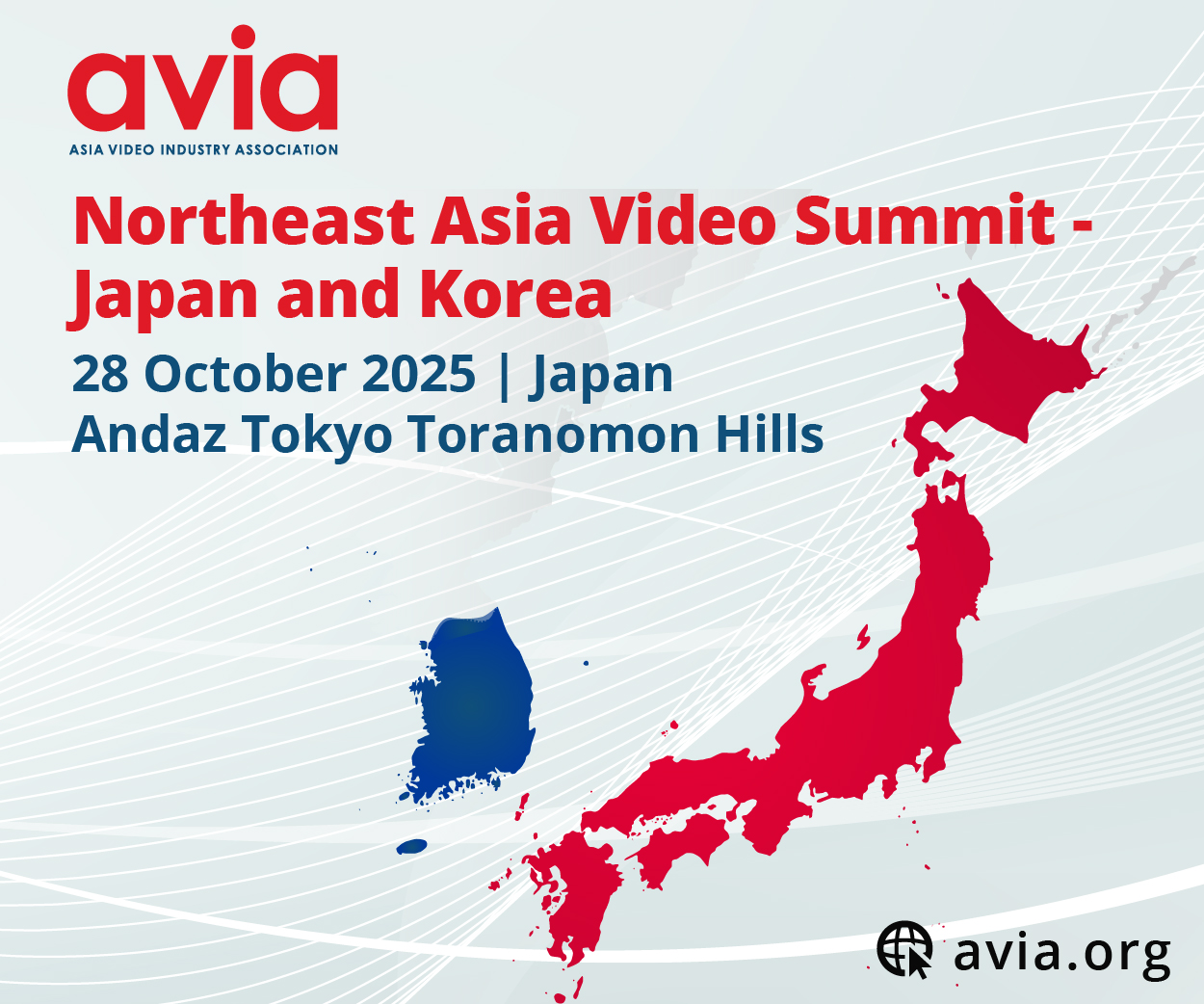
Paramount Animation president, Ramsey Naito, talks to Asian A.V. Club about her artistic upbringing, the techniques of being a good producer, and the creative direction she encourages among filmmakers in her orbit. “I always remember what my parents said to me – be happy, make aesthetic choices, know what they mean to you, and most importantly, find your people,” she says.
Ramsey Naito has spent her whole career working in animation. Starting as a production assistant and going on to produce feature films, she held executive roles at Nickelodeon Movies, Cartoon Network and Blue Sky Studios before becoming president of Paramount Animation in 2021.
Asian A.V. Club: You grew up without a television. I am wondering how that fostered your creativity? “Both my parents are artists. My father is a sculptor, my mother is a painter. My father is from Japan, and my mother is from New Orleans. When I was young, going to the movies and seeing films was very much a part of our itinerary. But TV was not. I think it was because my parents were like, entertain yourself. Draw, fantasise, create.
“My parents, probably with not having gone to a Waldorf school [Ed’s note: an education programme that puts high value in art, imagination, and creativity], were probably the closest thing to Waldorf parents. So, I grew up literally without a television until I was maybe 14 or 15, and even then, my mother decided to get a little black and white Zenith television.”
When creativity is part of your ‘normal’, what kind of kid were you? “I think the creative normal in my life allowed me to be innovative when things weren’t going to plan. When something broke, you figured out how to fix it. And it maybe wasn’t like the way it was before, but it’s maybe better or different. I love being creative and it’s my safe place, but in the end, I knew that even though I was seeing the world through this inspired lens, the relationships between people and engaging in everyday life was more important.”
You pursued an academic career in art schools. How did that transition into your early career working in animation? “I went to art school my entire life (Baltimore School for the Arts for high school, Maryland Institute College of Art, Cal Arts). I always remembered what my parents said to me: ‘be happy, make aesthetic choices, know what they mean to you, and most importantly, find your people’.”
�...
Paramount Animation president, Ramsey Naito, talks to Asian A.V. Club about her artistic upbringing, the techniques of being a good producer, and the creative direction she encourages among filmmakers in her orbit. “I always remember what my parents said to me – be happy, make aesthetic choices, know what they mean to you, and most importantly, find your people,” she says.
Ramsey Naito has spent her whole career working in animation. Starting as a production assistant and going on to produce feature films, she held executive roles at Nickelodeon Movies, Cartoon Network and Blue Sky Studios before becoming president of Paramount Animation in 2021.
Asian A.V. Club: You grew up without a television. I am wondering how that fostered your creativity? “Both my parents are artists. My father is a sculptor, my mother is a painter. My father is from Japan, and my mother is from New Orleans. When I was young, going to the movies and seeing films was very much a part of our itinerary. But TV was not. I think it was because my parents were like, entertain yourself. Draw, fantasise, create.
“My parents, probably with not having gone to a Waldorf school [Ed’s note: an education programme that puts high value in art, imagination, and creativity], were probably the closest thing to Waldorf parents. So, I grew up literally without a television until I was maybe 14 or 15, and even then, my mother decided to get a little black and white Zenith television.”
When creativity is part of your ‘normal’, what kind of kid were you? “I think the creative normal in my life allowed me to be innovative when things weren’t going to plan. When something broke, you figured out how to fix it. And it maybe wasn’t like the way it was before, but it’s maybe better or different. I love being creative and it’s my safe place, but in the end, I knew that even though I was seeing the world through this inspired lens, the relationships between people and engaging in everyday life was more important.”
You pursued an academic career in art schools. How did that transition into your early career working in animation? “I went to art school my entire life (Baltimore School for the Arts for high school, Maryland Institute College of Art, Cal Arts). I always remembered what my parents said to me: ‘be happy, make aesthetic choices, know what they mean to you, and most importantly, find your people’.”
“I met animators for the first time in grad school. And when we were graduating, they were getting jobs. So, they were like, ‘Hey, come get this job, work with us!’ And so, I applied for this job as a PA [production assistant] on Duckman. The interview went like this, “Do you know what a number 2 pencil is?” And I was like, “Yes.” “Do you know how to make Xerox copies?” “Yes.” And I got the job. It’s way more competitive now.”
“The first week working at [animation studio] KLaSKY CSUPO. I fell in love with it. I just fell in love with the community. Who knew there was an office job that employed so many artists all focused on one commercial idea, but also making their own art, and having their own practice. Animation is a vibrant community. It’s a commercial one. But the individuals working in it are fantastic.”
How did you move from animation into producing? “...I worked through art, production design, story. From "Duckman", to "Rugrats", "Santo Bugito", "The Wild Thornberrys" and eventually "The Rugrats Movie" [as supervising coordinator]. I left KLaSKY CSUPO to work on the "South Park" movie [unit production manager]. And then to Nickelodeon/the Paramount lot, where they asked me to oversee animated movie development.”
How did you prepare? “I learned on the job, and I learned from incredible people like Julia Pistor, who I worked for, Karen Rosenfelt and John Goldwyn, who were the heads of production, and Sherry Lansing, who was running the studio at the time. It really was the heyday of Paramount. Then I left and went to Cartoon Network where they wanted to build an animation division, but, funny enough, they pivoted and was like, we want you to focus on live action movies. So, I made live action movies for Cartoon Network. Then Blue Sky Studios offered me a job. Since I’m from New York, and my parents are there, I was like, ‘Okay, great. I’m coming home’. And was based out of Westchester County for about two and a half years, before I moved back into my old house in L.A. to produce The Boss Baby for Dreamworks Animation.”
As your role changed over the years, how did your relationship with the people making animation change? “I think being a producer and being an executive are really different, but the one thing they have in common in terms of managing people in this world of animation is having a relationship with the talent. It’s so important, being true partners, and being friends. You’re in it for the long haul. You’re making these movies for three to six years and a lot can happen in your personal life, let alone on a movie that you’re working on together.
“As a producer, I think it’s very important to always talk about the milestones on a film. We’re going to be here in three months. We’re going to be doing this in six months. Just putting things in context now, so that we can get to these moments in the future. On these films, you have a director and a very small team of key leadership comprised usually of production designer, art director, head of story editor, VFX producer, and they are all managing teams of people that can be anywhere from 200 to 400 people, which makes it a really collaborative process. It’s so important to communicate and streamline and make sure top down, everyone knows what they’re doing. And so, communication is key. Especially from a director who is poised to hear all the great ideas over the course of making a film, and their responsibility is to make the right ones.”
You are now back at Paramount as the president of Paramount Animation... there’s been a very positive approach to relaunching IPs like "Teenage Mutant Ninja Turtles" and "Transformers", while focusing on original storytelling and animation. Can you talk about the mandate you’re giving your creatives? “I love our culture at Paramount. Of course, there are pros and cons to everything, but we embrace a no style on all our movies, so they can be wildly different and driven by the vision of one person and maybe their team. On each picture, they have the ability to create a look that is specific and original, dare I say. And the way that we’re approaching these franchise films is as if they are originals, but they’re not.
“The secret weapon in making movies like "Teenage Mutant Ninja Turtles: Mutant Mayhem" and "Transformers One" is that we’re finding talent that had a deep connection from their childhood, where they were able to identify intuitively what mattered for the fans, and identify the areas that they’d never seen before, and take liberties to create something new and inspired.”
How so? “So, like on "Turtles", Jeff [Rowe, director] loved "Turtles". I remember when Brian Robbins [Paramount Pictures president and CEO] and I called him, he was thrilled that we were talking to him about the possibility of Turtles, and just spoke endlessly about the franchise in ways that only someone who loved it could. So, love is a secret ingredient.
“And then the visual inspiration is pretty cool. With Turtles, Jeff put his finger on being 15, and you’re scribbling and sketching all these things in the margins of your lined paper. Not really knowing how to draw anything yet but being fearless because no one’s told you that you can’t draw. Those drawings really represent the teenage years. And that was the inspiration and energy that made it through on screen that not only kept it fresh but celebrated the franchise.
As for "Transformers", it was being able to visualise a planet we’d never seen before. Seeing the planet Cybertron in its heyday, down to the last detail. That came from Josh [Cooley – director] and Jason Scheier [production design] really going for it. "Transformers One" is also a character story between Optimus Prime and Megatron. It’s their origins story where we see them as best friends who have a dream and begin to understand how their ideologies were born, what broke them up and made them become the revered iconic characters we know today.
“Josh added color in something we’d never seen before, taking characters, and then walking them backwards to being minors, to being empowered with the ability to transform, and not knowing what it meant, to becoming their glorious self. Every aspect of that film comes from a great reverence and understanding what the fans want.
“That originality ethos extends to upcoming films like the Smurfs and SpongeBob and more importantly, our originals that are coming.”
Animation might be one of the few places in Hollywood where there’s diversity among creatives working behind the scenes. Was that the case for you? “Actually, I was often the only Asian American in the room. But I think that with race and representation through art, often that became a real power in terms of representing Asians in animation.”
How do you make sure there is representation on Paramount Animation productions? “The teams behind the camera must be diverse when creating characters of colour in order to support and promote dialogue towards authenticity and breaking the stereotype. It’s critical. I’ve tried very hard to build teams that are diverse as possible, so that the dialogue can continue, because it must.
“A fascinating thing about animation is that 70% of animation students are women. Women are coming into our industry in a forceful way. They’re all coming out of school, and they’re all wanting jobs, and it’s going to move the needle in a way that we haven’t seen before. I think cultures are changing in order to embrace that... 55% of kids under the age of 12 are blended, are non-white. They want to see themselves on camera, and when they do, they want the characters to feel real.”
▶ Published in ContentAsia's Oct/Nov 2024 Magazine
ContentAsia is collaborating with the Asian A.V Club on interviews with Asian filmmakers and talent in Hollywood. Edited excerpts are available in ContentAsia. The full interviews are in the Asian A.V. Club newsletter at https://asianavclub.substack.com/























